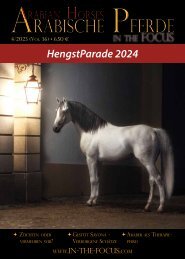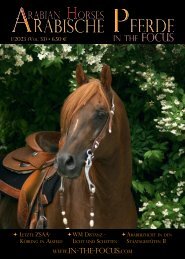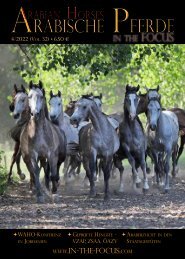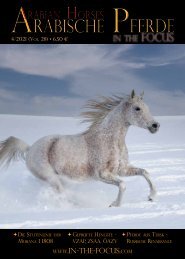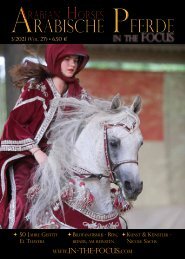Arabische Pferde IN THE FOCUS Nr. 2/2019 - Preview
Zeitschrift für Liebhaber arabischer Pferde
Zeitschrift für Liebhaber arabischer Pferde
Erfolgreiche ePaper selbst erstellen
Machen Sie aus Ihren PDF Publikationen ein blätterbares Flipbook mit unserer einzigartigen Google optimierten e-Paper Software.
Tradition and legacy<br />
Syria - like a Phoenix<br />
from the Ashes<br />
Who of the participants of the WAHO Conference 2007 in Syria does not fondly remember<br />
this country? In the following years, Syria had become one of my most preferred<br />
destinations in the Middle East - for its unique horse population, for its cultural heritage,<br />
but on top of all for its people. After eight years of war, I had now the chance to go<br />
back to see what's left.<br />
Breeding<br />
For me, Syria is the land of origin of our European<br />
(or Western) Arabian horse, because<br />
most of the purchasing commissions<br />
went to Syria, not to the Nedjd, to buy horses.<br />
They bought from the horse breeding Bedouin<br />
tribes in Syria and at the markets of Damascus<br />
and Aleppo, where the Bedouins often offered<br />
their horses, especially colts, through dealers.<br />
The Syrian people have preserved these horses,<br />
virtually unaltered, for Hundreds of years. To<br />
go to Syria is like going back in time. The pure<br />
Syrian Arabian horse is closest to what I would<br />
call the 'Bedouin horse', the type of horse that<br />
Baron von Fechtig, Count Rzewuski, Baron von<br />
Herbert, Colonel von Brudermann and many<br />
others, have brought to Europe in the 19th century.<br />
The Bedouin Horse<br />
By the end of the 17th, early 18th century, a<br />
group of Bedouin tribes moved north from the<br />
Arabian Peninsula, presumably because of a<br />
major plague and the rise of the Wahhabism<br />
in (today's) Saudi Arabia. These people largely<br />
belonged to two big tribal confederations, the<br />
Shammar, and the Anazeh. Most of the Shammar<br />
moved North and crossed over the Euphrates<br />
to live in north-eastern Syria and Iraq. The<br />
Anazeh tribal confederation - including tribes<br />
such as the Hassana, the Ruallah, the F'daan,<br />
and the S'baa instead spread out in the Syrian<br />
Badiya. Many of these tribes, from both the<br />
Anazeh and Shammar confederations, maintained<br />
strong ties to the Arabian Peninsula<br />
and have kept these connections alive even till<br />
today by marriage. Some of the descendants of<br />
the Shammar, Anazeh and Tai Bedouin tribes<br />
(links) Basil Jadaan with his mare Bint Shamkha<br />
( Shadeed / Shamkha) 2011 ,<br />
strain: Shwaima Sabbah<br />
Alle Fotos: G. Waiditschka / <strong>IN</strong> <strong>THE</strong> <strong>FOCUS</strong><br />
2/<strong>2019</strong> - www.in-the-focus.com<br />
are breeding "their" strains of Arabian horses<br />
since 300 years within their family - it is hard to<br />
find a more authentic Arabian horse today then<br />
the pure Syrian Arabian! Therefore I was really<br />
happy to go back to Syria after a break of eight<br />
years, to see what is left of this legacy.<br />
Visiting Syria<br />
"Is it really safe there?", was the most common<br />
questions, when I mentioned that I was invited<br />
to attend the 1st Al Sham International Arabian<br />
Horse Festival in Damascus last April. The<br />
answer, after coming back from this unique<br />
trip safe and sound, is "Yes, it is safe, at least<br />
in and around Damascus". After eight years of<br />
war, which is called "the unjust war against the<br />
Syrian people" by the Syrians themselves, I was<br />
more than happy to see that this country and its<br />
people slowly find their way back to something<br />
like "normality". The festival - of which it is said<br />
was attended by an estimated 100.000 people -<br />
was important for the Syrian breeders, for them<br />
to see that their efforts in preserving the Syrian<br />
Arabian horses during the difficult time of war<br />
are appreciated by the public, national and international,<br />
but also by the government. And<br />
so, the Syrian Arab Horse Association (SAHA)<br />
had great support from various Ministries, the<br />
city of Damascus, and other organizations in<br />
staging the festival.<br />
The Arabian horse is deeply rooted in the traditions<br />
and in the history of Syria, therefore<br />
the festival also included folklore, traditional<br />
craftsmanship, local food, dances, and much<br />
more. One of the highlights was the Grand<br />
Sham Arabian Horse Parade with close to 300<br />
riders parading through the streets of Damascus.<br />
It was a revival of the march on the occasion<br />
of the WAHO conference in 2007, and again,<br />
Thousands of spectators lined the streets along<br />
the 11 km stretch, eager to touch and pet the<br />
horses as they came along. Their riders, mostly<br />
in their traditional attire, enjoyed to parade<br />
13<br />
their horses and let them dance to the music of<br />
the boy (and girl!) scouts brass band. Young and<br />
old were on their feet and for the Syrians, this<br />
march had an especially significant meaning,<br />
as it took place on the Syrian Independence<br />
Day, commemorating Syria's proclamation of<br />
full independence and the end of the French<br />
mandate of Syria on 17 April 1946.<br />
The one-and-a-half hour march ended where<br />
it began, at the festival grounds at the Old Damascus<br />
Fair venue, which was - until a couple of<br />
months prior to the festival - just a rubble pit. It<br />
took 500 truckloads of rubble and debris to be<br />
trucked away, to clear the site. Help came also<br />
from the members of the Mahfouza sports club.<br />
This sports club is really not only about sports<br />
but also about art and music and on top of all<br />
a social project called "Bukra Elnad - tomorrow<br />
is ours": Children aged 3 to 15 are given the opportunity<br />
to get acquainted with various different<br />
activities, to find their favorite discipline<br />
and be trained in it, which helps them to overcome<br />
their war traumata. The best kids gave<br />
wonderful performances, either by painting the<br />
wall with Arabian horse motives, by decorating<br />
the entrance to the Fair Ground, by giving dance<br />
and music performances on the nightly stage,<br />
and many more activities. On the sad side,<br />
many of these children are war orphans.<br />
The Impact of the War<br />
A testimony of how deeply rooted the Arabian<br />
horse is with the Syrian people can be demonstrated<br />
by the fact, that as early as the 1950ies<br />
and 60ies, the Ministry of Agriculture had established<br />
stallion depots in the various Syrian<br />
governorates, and later, in 1994, a specialized<br />
Arabian Horse Office was created under the Ministry,<br />
which later became the studbook organization.<br />
In 2003, the Syrian Arabian Horse Association<br />
(SAHA) was founded, headed by Basil<br />
Jadaan, and in the following years, several activities<br />
were organized, such as races in Dama-



